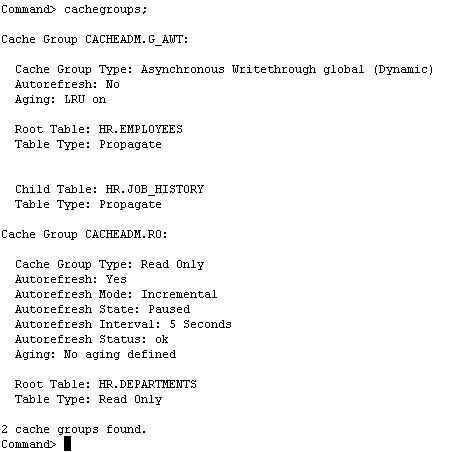A cache group is a collection of Oracle tables cached inside a TimesTen in-memory database. A cache database may contain one or more cache groups.
A cache group can be read-only or updatable. With a read-only cache group, updates in the Oracle database are automatically refreshed to the corresponding cache tables in the TimesTen database. With an updatable cache group, updates on cache tables are automatically propagated to the corresponding tables in the Oracle database.
The data in a cache group can be pre-loaded, or loaded on demand. Cache groups can be preloaded when the set of data to cache can be predetermined. A dynamic cache group is a cache group where the cache data is loaded on demand. This is appropriate when the set of data to cache cannot be predetermined.
There are two categories of cache groups:
- A local cache group contains data that is local to its cache database. The data is not shared by other members in a cache grid.
- A global cache group contains data that is globally shared by the other grid members. It ensures cache consistency across cache databases participating in the cache grid.
The examples below show how you can create a dynamic updatable global cache group, and a read-only local cache group.
1. Start the Cache agent2. Define the Cache Groups
Log in to ttIsql as the user cacheadm, passing in the TimesTen and Oracle user passwords for cacheadm.
ttIsql
connect "dsn=cachedb1_1122;uid=cacheadm;pwd=cacheadm;oraclepwd=cacheadm";
The cache agent process is responsible for managing the communication between cache databases, as well as controlling the data flow from an Oracle database to a TimesTen cache database.
Call the built-in procedure ttCacheStart to start the cache agent for the current database.
call ttcachestart;
Enter the following CREATE CACHE GROUP statements, to create a dynamic updatable global cache group named g_awt to cache the HR.EMPLOYEES and HR.JOB_HISTORY tables. Alternatively, run the script create_global_awt.sql located in the <install_dir>/quickstart/sample_scripts/cachegrid directory.
Either run the following script:
@<install_dir>/quickstart/sample_scripts/cachegrid/create_global_awt.sql;
or run the following code:
create dynamic asynchronous writethrough global cache group g_awt from
hr.employees ( employee_id number (6) not null,
first_name varchar2(20),
last_name varchar2(25) not null,
email varchar2(25) not null,
phone_number varchar2(20),
hire_date date not null,
job_id varchar2(10) not null,
salary number (8,2),
commission_pct number (2,2),
manager_id number (6),
department_id number(4),
primary key (employee_id)),
hr.job_history (employee_id number(6) not null,
start_date date not null,
end_date date not null,
job_id varchar2(10) not null,
department_id number(4),
primary key (employee_id,start_date),
foreign key (employee_id)
references hr.employees (employee_id));
Enter the following CREATE CACHE GROUP statement, or run the script create_local_ro.sql located in the <install_dir>/quickstart/sample_scripts/cachegrid directory to create a read-only local cache group named ro to cache the HR.DEPARTMENTS table.
Either run the following script:
@<install_dir>/quickstart/sample_scripts/cachegrid/create_local_ro.sql;
or run the following code:
create readonly cache group ro
autorefresh
interval 5 seconds
mode incremental
from
hr.departments (department_id number(4) not null primary key,
department_name varchar2(30) not null,
manager_id number(6),
location_id number(4));
The ttIsql command cachegroups can be used to verify the definitions of cache groups in the database.
cachegroups;
3. Start the Replication agent
(required only if there are asynchronous writethrough (AWT) cache groups)
4. Attach the Cache Database to the Cache Grid
The replication agent process is primarily responsible for the replicating data between TimesTen databases, but it is also responsible for propagating the updates from a TimesTen cache database to an Oracle database. This step is needed only if you have asynchronous writethrough (AWT) cache groups.
Call the built-in procedure ttRepStart to start the replication agent for the current database.
call ttrepstart;
(required only if there are global cache groups)
Call the procedure ttGridAttach to add the current cache database to the cache grid. This step is required only if you have global cache groups, or if you plan to perform global cache grid operations.
call ttgridattach (1, 'cachedb1', 'tthost1', 9991);
Note: tthost1 is the host name of the machine where the database cachedb1_1122 is located. The TCP/IP port number 9991 is arbitrary, but it should not conflict with other TCP ports (e.g. ftp, telnet etc.), specifically the hostname + port combination should be unique.
Use the procedure ttGridNodeStatus to list all the attached grid members, and verify that cachedb1_1122 has joined the cache grid samplegrid.
call ttgridnodestatus;
Once the cache groups have been created and the required processes have been started,
you can start loading data into the cache tables. For more information on how to load data into cache groups,
refer to the section Loading Data into Cache Groups
| 1 | 2 | Next > |

